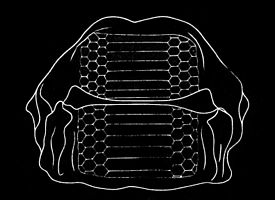chin is remarkable as the first animal, and below mollusks and articulates the only animal, possessing any organs for mastication. Furthermore, its dental apparatus is perhaps of greatest complexity in the whole animal kingdom. Five triangular teeth set in as many jaws surround the opening to the stomach, and move toward a central point. They seize and divide the food which then passes between the masticating jaws. The latter are grooved, and, aided by saliva, effectually crush and grind the food. The muscles and levers necessary to efficient action are numerous and intricate, altogether forming an apparatus entirely unique in form and principle.
Among mollusks the gasteropods or snails, and the cephalopods, which include the cuttle and devil-fishes, have masticating organs. Most snails have thousands of minute teeth on the tongue. These are, however, chiefly used for procuring food by a rasping or boring motion. But some snails, not satisfied with lingual teeth alone, indulge the absurdity of carrying powerful teeth in the stomach. The beak of the cuttle-fish divides the food somewhat, but the masticating process is mainly performed by a gizzard.
Articulates have a much greater variety of masticating organs. Nearly all, even some of the worms, have efficient jaws for seizing food, which also serve to cut and crush the same.

Fig. 3.—Jaws and Pavement-teeth of a Ray (Myliobates).
Imagine a creature with so little regard for the proprieties as to chew food with its legs! Yet the common limulus, or "horseshoe crab," actually grinds the food between its thighs. However, this is not so strange, when we understand that the claws of the lobster and crab are simply modified legs; and that many higher animals, the squirrel and cat, for instance, use their feet in eating.
Another group of crustaceans, the little rotifers, pound their food. The lower jaw serves the purpose of an anvil upon which the food is crushed by two hammers formed from the upper jaw. Lobsters and crabs masticate with their horny jaws; but they all have complete and efficient sets of teeth in the gizzard-like stomach. And, when the shell is cast, the teeth are also shed along with the stomach-lining. Those
